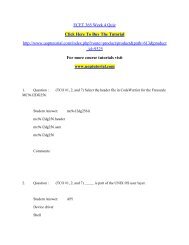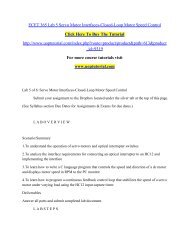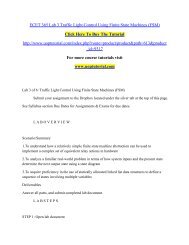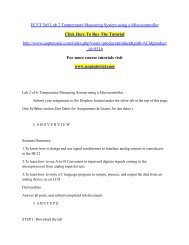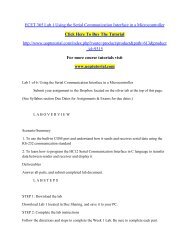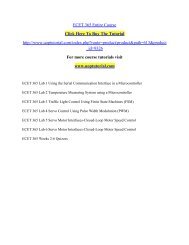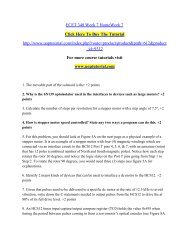ECET 365 Week 6 Quiz
1. Question : (TCO #6) How many 16-bit PWM channels are available in the Freescale 9S12DG256 microcontroller? Student Answer: Two Four Seven Eight Comments: 2. Question : (TCO #6) When concatenating the two 8-bit PWM Channels 3 and 2 to get a 16-bit PWM channel, _____ becomes the low-order byte. Student Answer: Channel 7 Channel 2 Channel 5 Channel 3 Comments: 3. Question : (TCO #6) To enable Channel 7 of the PWM to 9S12DG256, which of the following must be done? Student Answer: Set PWME7 = 1 Set PWME7 = 0 Set CAE7 = 1 Set CAE7 = 0 Comments: 4. Question : (TCO #6) What is Clock SA when PWMSCLA = 0x01 and Clock A = 4MHz? Student Answer: 5MHz 4MHz 8MHz 2MHz Comments: 5. Question : (TCO #6) What is Clock SA when PWMSCLA = 0x00 and Clock A = 8MHz? Student Answer: 8MHz 15625Hz 8MHz 31250Hz Comments: 6. Question : (TCO #6) A bus clock is set to 4000 kHz. What is the Clock A’s value if PWMPRCLK = 0x02? Student Answer: 1MHz 3MHz 2MHz 8MHz Comments: 7. Question : (TCO #6) In case of center-aligned PWM, which formula can be used for the duty cycle of the output waveform? Student Answer: Duty Cycle = [(PWMPERx - PWMDTYx) / PWMPERx] * 100% Duty Cycle = [PWMDTYx / PWMPERx] * 100% Duty Cycle = PWMDTYx 100% Both A or B (depends on PPOLx) Comments: 8. Question : (TCO #6) In case of center-aligned PWM, which formula can be used for the PWM frequency? Student Answer: PWMx frequency = Clock (A, B, SA, or SB) / PWMPERx PWMx frequency = Clock (A, B, SA, or SB) / (2 * PWMPERx) PWMx frequency = Clock (A, B, SA, or SB) / (4 * PWMPERx) PWMx frequency = Clock (A, B, SA, or SB) / (3 * PWMPERx) Comments: 9. Question : (TCO #6) Current passing through a wire creates an electromagnetic field that _____. Student Answer: loops around the wire is directly proportional to the amount of the current flowing inside the wire is strongest closer to the wire satisfies all of the above answers Comments: 10. Question : (TCO #6) PWM channels of a microcontroller are designed for control of a _____. Student Answer: servo motor AC motor stepper motor None of the above
1. Question : (TCO #6) How many 16-bit PWM channels are available in the Freescale 9S12DG256 microcontroller?
Student Answer: Two
Four
Seven
Eight
Comments:
2. Question : (TCO #6) When concatenating the two 8-bit PWM Channels 3 and 2 to get a 16-bit PWM channel, _____ becomes the low-order byte.
Student Answer: Channel 7
Channel 2
Channel 5
Channel 3
Comments:
3. Question : (TCO #6) To enable Channel 7 of the PWM to 9S12DG256, which of the following must be done?
Student Answer: Set PWME7 = 1
Set PWME7 = 0
Set CAE7 = 1
Set CAE7 = 0
Comments:
4. Question : (TCO #6) What is Clock SA when PWMSCLA = 0x01 and Clock A = 4MHz?
Student Answer: 5MHz
4MHz
8MHz
2MHz
Comments:
5. Question : (TCO #6) What is Clock SA when PWMSCLA = 0x00 and Clock A = 8MHz?
Student Answer: 8MHz
15625Hz
8MHz
31250Hz
Comments:
6. Question : (TCO #6) A bus clock is set to 4000 kHz. What is the Clock A’s value if PWMPRCLK = 0x02?
Student Answer: 1MHz
3MHz
2MHz
8MHz
Comments:
7. Question : (TCO #6) In case of center-aligned PWM, which formula can be used for the duty cycle of the output waveform?
Student Answer: Duty Cycle = [(PWMPERx - PWMDTYx) / PWMPERx] * 100%
Duty Cycle = [PWMDTYx / PWMPERx] * 100%
Duty Cycle = PWMDTYx 100%
Both A or B (depends on PPOLx)
Comments:
8. Question : (TCO #6) In case of center-aligned PWM, which formula can be used for the PWM frequency?
Student Answer: PWMx frequency = Clock (A, B, SA, or SB) / PWMPERx
PWMx frequency = Clock (A, B, SA, or SB) / (2 * PWMPERx)
PWMx frequency = Clock (A, B, SA, or SB) / (4 * PWMPERx)
PWMx frequency = Clock (A, B, SA, or SB) / (3 * PWMPERx)
Comments:
9. Question : (TCO #6) Current passing through a wire creates an electromagnetic field that _____.
Student Answer: loops around the wire
is directly proportional to the amount of the current flowing inside the wire
is strongest closer to the wire
satisfies all of the above answers
Comments:
10. Question : (TCO #6) PWM channels of a microcontroller are designed for control of a _____.
Student Answer: servo motor
AC motor
stepper motor
None of the above
- No tags were found...
Create successful ePaper yourself
Turn your PDF publications into a flip-book with our unique Google optimized e-Paper software.
<strong>ECET</strong> <strong>365</strong> <strong>Week</strong> 6 <strong>Quiz</strong><br />
Click Here To Buy The Tutorial<br />
http://www.uoptutorial.com/index.php?route=product/product&path=613&product<br />
_id=9323<br />
For more course tutorials visit<br />
www.uoptutorial.com<br />
1. Question : (TCO #6) How many 16-bit PWM channels are available in the Freescale<br />
9S12DG256 microcontroller?<br />
Student Answer:<br />
Two<br />
Four<br />
Seven<br />
Eight<br />
Comments:<br />
2. Question : (TCO #6) When concatenating the two 8-bit PWM Channels 3 and 2 to<br />
get a 16-bit PWM channel, _____ becomes the low-order byte.<br />
Student Answer: Channel 7<br />
Channel 2<br />
Channel 5
Channel 3<br />
Comments:<br />
3. Question : (TCO #6) To enable Channel 7 of the PWM to 9S12DG256, which of the<br />
following must be done?<br />
Student Answer: Set PWME7 = 1<br />
Set PWME7 = 0<br />
Set CAE7 = 1<br />
Set CAE7 = 0<br />
Comments:<br />
4. Question : (TCO #6) What is Clock SA when PWMSCLA = 0x01 and Clock A =<br />
4MHz?<br />
Student Answer:<br />
5MHz<br />
4MHz<br />
8MHz<br />
2MHz
Comments:<br />
5. Question : (TCO #6) What is Clock SA when PWMSCLA = 0x00 and Clock A =<br />
8MHz?<br />
Student Answer:<br />
8MHz<br />
15625Hz<br />
8MHz<br />
31250Hz<br />
Comments:<br />
6. Question : (TCO #6) A bus clock is set to 4000 kHz. What is the Clock A’s value if<br />
PWMPRCLK = 0x02?<br />
Student Answer:<br />
1MHz<br />
3MHz<br />
2MHz<br />
8MHz<br />
Comments:
7. Question : (TCO #6) In case of center-aligned PWM, which formula can be used for<br />
the duty cycle of the output waveform?<br />
Student Answer: Duty Cycle = [(PWMPERx - PWMDTYx) / PWMPERx] * 100%<br />
Duty Cycle = [PWMDTYx / PWMPERx] * 100%<br />
Duty Cycle = PWMDTYx 100%<br />
Both A or B (depends on PPOLx)<br />
Comments:<br />
8. Question : (TCO #6) In case of center-aligned PWM, which formula can be used for<br />
the PWM frequency?<br />
Student Answer:<br />
PWMx frequency = Clock (A, B, SA, or SB) / PWMPERx<br />
PWMx frequency = Clock (A, B, SA, or SB) / (2 * PWMPERx)<br />
PWMx frequency = Clock (A, B, SA, or SB) / (4 * PWMPERx)<br />
PWMx frequency = Clock (A, B, SA, or SB) / (3 * PWMPERx)<br />
Comments:
9. Question : (TCO #6) Current passing through a wire creates an electromagnetic field<br />
that _____.<br />
Student Answer:<br />
loops around the wire<br />
is directly proportional to the amount of the current flowing inside the wire<br />
is strongest closer to the wire<br />
satisfies all of the above answers<br />
Comments:<br />
10. Question : (TCO #6) PWM channels of a microcontroller are designed for control of<br />
a _____.<br />
Student Answer:<br />
servo motor<br />
AC motor<br />
stepper motor<br />
None of the above




